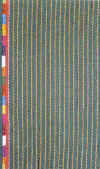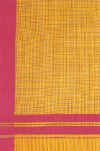|
|
|
||||
|
APRIL 2002 Contents
Travel 'Baikunth'
- the mountain Literature Visual Arts Jatin
Das - 4 decades of Music Zakir
Hussain - Compelling Hakim
Ajmal Khan's ancestral Business & Economy Performing Arts 'Fakir
of Benares' -1922 French Films Revathy
Menon's 'Mitr - my Books 'Knock
at Every Alien Door' People
Books
|
|
|
|||
| print gallery | |||||
|
Page 1 of 4
Textiles of Pakistan - Past & Present by Shehnaz Ismail. The subcontinent is the inheritor of one of the richest and oldest textile traditions in the world. Excavations at Mohenjo Daro and Harappa 2500-1500 BC revealed that the inhabitants of the Indus Valley cultivated cotton. Sir John Marshall, the archaeologist has stated that a few minute scraps of cotton were found adhering to the side of a silver vase. Clay and faience spindles whorls indicate that cotton and woolen fibers were spun. A well-equipped dyers’ workshop was excavated at Mohenjo Daro and the fragment of cloth indicates that woven cotton cloth was dyed with madder root. In 1947, Pakistan inherited only one textile mill, the Lyallpur Cotton Mill in Lyallpur, now called Faisalabad. Today there are 450 Spinning mills and 35 composite textile mills. Textile goods form 60 % of the total exports of Pakistan.
The King Priest of Mohenjo Daro 2500-1500 BC stands on the banks of the River Indus, looking out across the abundant cotton fields of Lower Sindh. Draped across his left shoulder is a shawl with a trefoil motif symbolizing three sun disks, fused together to represent the inseparable unity of the power of sun, water and earth. Along the banks of the same river, probably in the same spot, stands a young man 3000 years later, draped in a cotton chadar [shawl] the Ajrak, with the Kakar design [cloud pattern] resembling the trefoil motif. Much has changed and evolved over time, but the rituals and crafts have remained unaltered over the last millennium. The subcontinent is the inheritor of one of the richest and oldest textile traditions in the world. Excavations at Mohenjo Daro and Harappa 2500-1500 BC revealed that the inhabitants of the Indus Valley cultivated cotton. Sir John Marshall, the archaeologist has stated that a few minute scraps of cotton were found adhering to the side of a silver vase. Clay and faience spindles whorls indicate that cotton and woolen fibers were spun. A well-equipped dyers’ workshop was excavated at Mohenjo Daro and the fragment of cloth indicates that woven cotton cloth was dyed with madder root. Textiles have evolved with migration and urbanization, and acquired a synthesis of different sensibilities. The manufacture of sophisticated textiles in the subcontinent is as ancient as its civilization. In the religious texts of the Hindus, the Rig Veda and the Upanishads, the universe is envisioned as a fabric woven by the Gods. The cosmos is referred to as a continuous fabric with its warp and weft making a grid pattern upon which all is painted. These early literary references to fabric verify the subcontinent as a producer of textiles and master dyer to the world. Although only a few biodegradable fragments of woven plant and animal fiber remain, archaeological finds and literary references amply support the picture of a mystical and vibrant world associated with textiles. Literary evidences of Herodotus‘ travels to India in the sixth century BC and Pliny’s Historia Naturalis proves that the subcontinent has been the home of cotton [ Gossypium arboreum] since prehistoric times. Accounts written by the Chinese pilgrims Fa Hsien and Huen Tsang in the 5th and 7th century indicate the availability of a wide range of cotton and woolen fabrics used for clothing. Kautilya’s technical treatise called Arthashatra written during the third century BC mentions important cotton, silk and woolen textile centers involved trade. Animal Fibers such as silk and wool can be dyed easily. But cotton, a vegetable fiber resists saturation and until the 17th century Indians alone had mastered the complicated chemistry of cotton dyeing, involving proper permeation of the fibers rather than mere application of pigments to the surface. Rightly so, they were called the "master dyers to the world". Few examples were known to have survived outside India, until the discovery in the 19th century of trade cloth unearthed at Al-Fustat, an Arab entrepot in Egypt. The fabrics approximately dated to the 13th century are hand-woven cotton cloth, blocked and resist painted with the floral patterns of Persian influence, geometric patterns and a mythical beast motif, which links them to Gujarat [ western India] where many of the same patterns appear in architecture and miniature paintings of the 15th century, and are still in use today. The history of the vast subcontinent, multivalent and multicultural, from the time the first Indo-Aryans from Central Asia entered the Indus Valley to the time of Independence from the British colonial rules in 1947, has been a series of invasions that have flowered into empires, bloomed and decayed. Religions such as Buddhism, Jainism and Islam in the 8th century AD have added yet another dimension to its already vibrant cultural diversity.
|
|||||
| Copyright © 2000 [the-south-asian.com]. Intellectual Property. All rights reserved. | |||||
| Home | |||||



